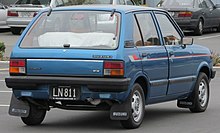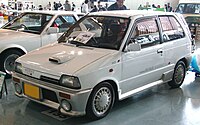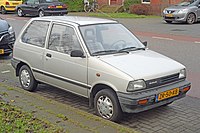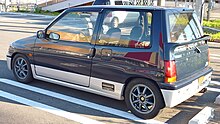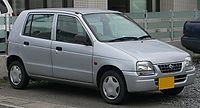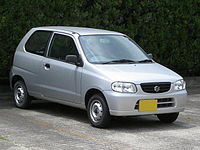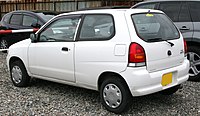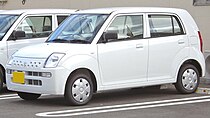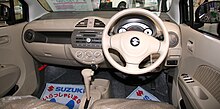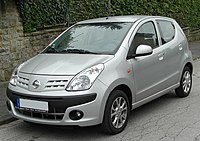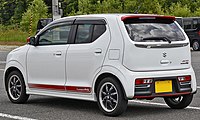Suzuki Alto
| Suzuki Alto | |
|---|---|
 Suzuki Alto 4th generation (1994–1998) | |
| Overview | |
| Manufacturer | Suzuki |
| Also called | |
| Production | 1979–present |
| Body and chassis | |
| Class | |
| Body style | |
| Layout | |
TheSuzuki Alto(Japanese:スズキ・アルト,Hepburn:Suzuki Aruto)is akei carproduced bySuzukisince 1979. The model, currently in its ninth generation, was first introduced in 1979 and has been built in many countries worldwide. The Alto originated as acommercial vehiclederivative of theFronte,but over time the Alto nameplate gained in popularity and by 1988 it replaced the Fronte name completely. The Alto badge has often been used on different cars in Japan and in export markets, where it is considered acity car.
Nameplate history
[edit]In Japan, the Alto badge was originally meant to be for the commercial use version of theFrontepassenger car. The word "alto"is a musical term. When introduced, the Alto was only available as a three-door" light van "and with bare-bones equipment. However, Suzuki generally did not use the" Fronte "badge in export, usually calling all versions" Alto "abroad. Most early export Altos were thus technically speaking rebadged Suzuki Frontes. These were exported with changes such as enlarged engines, sometimes modified bodywork. Thus the Japanese SS40 Fronte became the SS80 Alto with a 660 cc engine abroad. The Alto badge gradually took over in Japan as well, as the distinction between kei commercial vehicles and passenger cars was diminished in early 1989. The Fronte line was retired in March 1989. The Alto plate has been used on export versions of various Indian-built derivatives since the early 1990s, as neither cars are restricted by the kei rules and Indian cars are also considerably cheaper than Japanese-built ones.
Thus, the European-market models were actually:
- 1981–1984:SS40Fronte with a 40 PS (29 kW) 796 cc three-cylinder engine (SS80F/G).
- 1984–1994:CA/CB91Alto/Fronte (also referred to as SB308) with the same 40 PS (29 kW) F8B engine as the SS80.
- March 1994[1]–2002:Maruti Zen(a wider version of theSuzuki Cervo Mode), with a 993 cc engine.
- 2002–2009:Maruti Suzuki Alto(based on theHA12Alto), with a 1061 cc four-cylinder engine. Sold until 2012 in other markets.
- 2009–2014:Maruti Suzuki A-Star,with a 998 cc engine.
In 2014, theSuzuki Celerioreplaced the Alto in Europe and many other export markets.[2]Outside of the Japanese domestic market, the Alto badge remains used on the second generation of Indian-builtMaruti Altoswhich is generally sold as a Suzuki in export markets.
First generation (1979)
[edit]| First generation | |
|---|---|
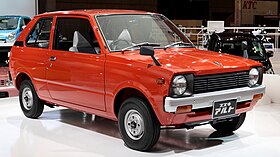 | |
| Overview | |
| Model code | SS30/SS40 |
| Also called | Suzuki Fronte Suzuki FX Suzuki Hatch Maruti 800 |
| Production | 1979–1984 |
| Assembly |
|
| Body and chassis | |
| Body style | 3/5-doorhatchback 3-door van |
| Layout | Front-engine, front-wheel-driveorfour-wheel-drive |
| Powertrain | |
| Engine | |
| Transmission | 4-speedmanual |
| Dimensions | |
| Wheelbase | 2,150 mm (84.6 in) |
| Length | 3,195 mm (125.8 in) |
| Width | 1,395 mm (54.9 in) |
| Height | 1,335 mm (52.6 in) |
| Curb weight | 530–570 kg (1,170–1,260 lb) |
The first generation (SS30V/40V), introduced in May 1979, is a three-door cargo version of theFrontepassenger car, equipped with a folding rear seat. Front suspension comprised coilsstruts,withleaf springsat the back. The steering was of therecirculating balltype, and four-wheeldrumswere used.[6]On introduction, the Alto received theT5Btwo-stroke539 cc (32.9 cu in) (SS30)three-cylinderengine, producing 28 PS (21 kW) at 5500 rpm. The Alto was a "micro sensation" when introduced, largely due to its rock bottom price of ¥470,000 (circa $1,900 in 1979, at a time when the cheapestFord Pintocost $4,999 in the US).[7]This low price was made possible by a number of Japanese special concessions for commercial vehicles: most notably, the engine was subject to less stringent emissions rules and did not require expensive twin catalysts. Two fewer doors provided another saving, as did the exemption from commodity tax.[7]Initially, Suzuki only offered a single model to avoid additional development costs and to avoid making buyers feel short-changed by not buying more expensive variants. In spite of the relentless cost cutting, Suzuki did increase the safety standards with standard equipment not typically found in kei cars at the time, such as three-point belts in front and individually fused headlamps (so that if a fuse were to blow, one headlamp would still work).[8]
The Alto's success changed the kei-car market, and other producers such as Subaru (with the "Family Rex") quickly followed suit with cut-price" commercial "vehicles that were really intended for private use.[7]Suzuki was unable to keep up with demand the first few years, particularly in the home market.[9]The Alto helped Suzuki move into seventh place in Japanese production for cars and trucks.[10]In the last full year of production for this generation, it was still by far the best selling Kei car, with the Alto outselling the passenger-oriented Fronte at a rate of about five to two.[11]
In May 1980, a fully automatic two-speed option was added to the Alto SS30. In January 1981, theF5Afour-stroke543 cc (33.1 cu in) from the Fronte was also made available for the Alto; although it only had a single-barrelcarburettor,it too put out 28 PS (21 kW) but at 6,000 rpm. Torque was considerably lower, however, down from 5.3 to 4.2 kg⋅m (52 to 41 N⋅m; 38 to 30 lb⋅ft).[12]1981 was also when it became available in the United Kingdom, as Suzuki began selling cars there that year.
In export markets, the Alto name was used for the passenger car versions (chassis codes with trailing letter "S" ) as well as on commercials (ending in "V" ), while the van was marketed as the "Suzuki Hatch" in Australia. The four-doors were not proper hatchbacks, only featuring an opening rear window. Export cars were also available with twelve-inch wheels, unlike the domestic versions which only used ten-inch units until the introduction of the4WDversion in October 1983. The 4WD "Snow Liner" thus gained an extra 2.5 cm (1 in) of ground clearance.[13]Most export Altos were passenger car versions (which used the "Fronte" badge in the Japanese domestic markets), and usually received the 796 cc (48.6 cu in)F8B engineand the SS80 chassis code. The 800 had better performance, and due to the higher possible gearing it saw an improved fuel mileage as well - by about ten percent according to Suzuki.[6]The SS80 was also built in New Zealand, by South Pacific Suzuki Assemblers at a rate of six per day. It was introduced in New Zealand in March 1980.[4]
While Suzuki held on to the two-stroke engine concept for a half decade longer than any of its Japanese competitors, eventually market pressures and ever tightening emissions regulations spelled its end in the Alto by September 1981. TheJimny,however, did use the same 539 cc (32.9 cu in) engine(called LJ50 in the Jimny)as late as 1987.
Between 1983 and 1986, this generation Alto was built in India as theMaruti Suzuki 800.By 1984, the 800 cc Alto/Fronte (called "FX" ) were introduced in Pakistan and were locally manufactured byPak Suzuki Motorsalong with the 1000 ccJimny(SJ410).[5]
Suzuki Hatch (Australia)
[edit]In Australia, the SS40V was sold as theSuzuki Hatch,only available as a two-seat commercial vehicle. This meant it was taxed at 35 percent duty as opposed to 57.5 percent for passenger cars, and sales were not affected by Australia's then-quotaon import cars.[9]The Hatch originally offered a single-carburetted 543 cc (33.1 cu in) engine with 19.2 kW (26.1 PS; 25.7 bhp) at 6000 rpm and 35 N⋅m (26 lb⋅ft) at 4000 rpm.[9]The side rear windows were covered with fibreglass by default, with a glass panels optional. The only other option was air conditioning.[6]The Hatch was by far the cheapest new car sold in Australia at the time, although equipment was limited: the buyer received standard vinyl seats and mats and cross ply tires, with the only concession to luxury being a push-button AM radio.[9]M. W. Suzuki inVictoria,Suzuki's distributor for Southern Australia, introduced the "800 pack" in January 1981 that included the 796 cc (48.6 cu in) motor.[6]The pack also added steel-belt radial tyres, 12-inch wheels (up from 10-inch), front-wheeldisc brakesand bolder bumpers front and rear.[6]
Second generation (1984)
[edit]| Second generation | |
|---|---|
 Suzuki Alto "Juna" Special Edition (CA72) | |
| Overview | |
| Model code | CA/CB/CC |
| Also called |
|
| Production |
|
| Assembly |
|
| Body and chassis | |
| Body style | 3/5-doorhatchback |
| Layout | Front-engine, front-wheel-drive(CA/CB) orfour-wheel-drive(CC) |
| Related | Suzuki Cervo |
| Powertrain | |
| Engine | |
| Transmission | 4/5-speedmanual 2/3-speedautomatic |
| Dimensions | |
| Wheelbase | 2,175 mm (85.6 in) |
| Length | 3,195 mm (125.8 in) |
| Width | 1,395 mm (54.9 in) |
| Height | 1,400–1,435 mm (55.1–56.5 in) |
| Curb weight | 540–630 kg (1,190.5–1,388.9 lb) |
The second generation (CA71) was introduced in September 1984. This generation Alto echoed the design of the GM M-platform that underpinned the 1983 Suzuki Cultus. It continued with the F5A engine of the SS40, but also became available withturbochargedand multi-valve engines thereof, mainly in the "Works" series. In December 1984, afour-wheel-driveversion (CC71) was added; until it arrived Suzuki had kept the four-wheel-drive version of the first generation Alto (SS41) on offer.[14]Performance versions of the Alto family first appeared in September 1985, when a fuel injected and turbocharged engine with 44 PS (32 kW) was made available; this could also be had in combination with four-wheel-drive.[15]The Alto Turbo gradually acquired more performance-related modifications until the Alto Works version was introduced in February 1987. This was the firstkei carto reach the legal limit of 64 PS (47 kW). It acquired considerable popularity, withmodelsof it still made byFujimi.
A five-door body became available on the Alto in October 1985. This was superficially identical to that of theFronte's,but the rear seat folded flat and it was technically speaking a commercial vehicle. This was the first five-door commercial of its kind in Japan, and was originally a special model introduced to celebrate the one millionth Alto produced. TheCBmodel code was not used on the Alto in Japan, as it signifies the passenger car version which was still sold as a Fronte in the home market.
In July 1986, the CA/CC71 received a rather thorough facelift. New wraparound headlights, a new dash and interior heralded the new available ITL rear suspension (IsolatedTrailingLink), athree-link rigidsetup. Some lower end models retained the earlier leaf sprung rigid axle; those with ITL received theCA/CC72chassis code.[16]A"Walkthrough Van"was introduced in January 1987, while at the other end of the spectrum, the personalcoupéCervoon the CA/CC72 base was introduced in 1988 with a new 547 cc (33.4 cu in)F5Bengine. In August 1987, higher spec Altos became available with a three-speedautomaticrather than the two-speed unit that had been used before.
-
Suzuki Alto "Juna" Special Edition (CA72; rear view)
-
Suzuki Alto Works RS-R (CC72)
-
Rear view of Works RS-R
Other markets
[edit]Most export markets received the passenger car version, which would have been badged "Suzuki Fronte" in Japan, but were usually sold as Altos abroad. When equipped with the 543 cc F5A engine, the export model code isSB305.Most cars sold outside of Japan, however, received the larger (0.8 litres) F8B engine and theSB308model code.
Europe
[edit]The 796 cc, 41 hp (30 kW) F8B-enginedCA/CB91was sold in Europe with either a four-speedmanualor two-speed automatic transmission. Export Altos were technically speakingFrontes,as this was the name used for passenger versions in Japan. They received larger bumpers, making them 105 mm (4.1 in) longer and 10 mm (0.4 in) wider. European Altos received the same facelift as the CA/CB72 did in early 1987 (a little later than in Japan), followed by a market specific facelift in January 1988, unveiled at the Brussels Motor Show.[17]This model remained in production (latterly by Maruti Udyog) for the European market until 1993, when it was replaced by an also Maruti-built 1-litre version of theCervo Mode,which was sold as the Alto until 2002. TheMaruti 800did continue to be available under its own name in Europe until 2004, when it could no longer pass emissions and safety requirements.[18]
-
Suzuki Alto GL 3-door (pre-facelift)
-
Suzuki Alto 800 5-door (pre-facelift)
-
Suzuki Alto GL 3-door (facelift)
India
[edit]The Suzuki Alto was produced and sold in India as theMaruti 800between late 1986 and 2014, succeeding the previous generation which had been built there since 1983.
Pakistan
[edit]While the car has been long retired in other markets, it remained in production in Pakistan under the monikerSuzuki Mehran.The Pakistani version is essentially a simplified basic rebadged second-generation Suzuki Alto CA/CB91 which was sold in the Japanese and European market from 1984 to 1988. The Mehran remained in production due to its cost effective nature and cheap parts availability.[19]In March 2019, the moniker Mehran officially ended its production after over 30 years of production, replaced by the eighth-generation Alto.
China
[edit]Around 1990, the China Ordnance Industries Corporation (COIC, a predecessor company toNorinco) purchased the complete rights and all machinery for manufacturing the SB308 Alto from Suzuki. COIC charged four hitherto military enterprises with manufacturing the Alto: Chongqing Chang'an, Jilin Jiangbei, Xiangtan Jiangnan, and Xi'an Qinchuan were all to switch over to civilian manufacture. Chongqing Chang'an were able to adapt Suzuki'sjust-in-time manufacturing(JIT) methods and were the first to market the car, in 1992. Jilin Jiangbei lost money on each car built and ended up on the brink of bankruptcy; Xiangtan Jiangnan never got production off the ground, while Xi'an Qinchuan suffered a fire and chose to develop their own design instead (a car called theQinchuan Flyer;the company was later made part ofBYD Auto). Chang'an ended up without real competition in the segment.[20]Chang'an's productivity set a new standard for the Chinese auto industry.
In 1993,Changan Automobiletook over production of the Alto.[21]TheChangan SuzukiSC7080 Alto was produced with the same F8B engine as used in other export markets, and was replaced by the facelifted SC7081 Alto/City Baby/Little Prince/Happy Prince in 2001. The top-of-the-line Happy Prince, discontinued in 2007, used the sportier looking front bumper, grille, and bonnet of the Alto Works. Citing lower sales and stating that upgrading the design to meet new regulations would not be cost effective, Chang'an ended production of the old Alto on 28 July 2008. A total of 504,861 were built by Chang'an Suzuki between 1993 and 2008.[20]
Another version calledJN Autohas been built byJiangnan Auto.[22]As of December 2010 Zotye's Jiangnan Alto is one of the cheapest car in the world, with a price tag of $2830.[23]The entry-level model comes with the 796 cc (48.6 cu in) F8B three-cylinder 36 PS (26.5 kW).[citation needed]Aninline-four enginewith a displacement of 1,051 cc (64.1 cu in) and an output of 52 PS (38.5 kW) was also available. The Jiangnan TT was eventually replaced by theZotye Z100in 2010.
Third generation (1988)
[edit]| Third generation | |
|---|---|
 1992 Suzuki Alto Fe-P 4WD 5-door (CS22) | |
| Overview | |
| Model code | CL/CM/CN/CP/CR/CS |
| Also called | Suzuki Fronte Daewoo Tico Autozam Carol |
| Production | 1988–1994 1991–2001 (Daewoo Tico) |
| Assembly | Japan:Kosai, Shizuoka |
| Body and chassis | |
| Body style | |
| Layout | Front-engine, front-wheel-driveorfour-wheel-drive |
| Powertrain | |
| Engine | |
| Transmission | |
| Dimensions | |
| Wheelbase | 2,335 mm (91.9 in) |
| Length |
|
| Width | 1,395 mm (54.9 in) |
| Height | 1,380 mm (54.3 in) 1,685 mm (66.3 in) (Alto Hustle)[24] |
| Curb weight | 540–730 kg (1,190.5–1,609.4 lb) |
The third generation (CL/CM11) replaced the CA71 in September 1988. This was the last generation of Alto to have an associated Fronte model. It had strikingly angular styling, with an unusual glazed C-pillar on the 5-door. Another curiosity of this generation was the availability of a version with a sliding door on the driver's side, the "Slide Slim", intended to simplify entering and exiting in tight spaces. It also made egress easier for the old and the infirm. The Slide Slim has two regular doors on the passenger (left) side. This door type wouldn't be used for some time until the arrival of theToyota PorteandPeugeot 1007.When theFrontename was discontinued in October 1989, the passenger car versions (CN/CP11) became Altos. Initially the CL11 used the 12-valve 42 PS (31 kW)F5Bengine known from the SS71 Cervo, but with an added 34 PS (25 kW) 6-valve version in lower-spec versions. A 46 PS (34 kW)DOHCversion was also available in theTwin Cam Rl.Passenger car versions had the same engines, but all with 2 PS less due to more stringent emissions controls. The fuel-injected, 6-valve, turbochargedWorksmodels came with anSOHC58 PS (43 kW) engine (FFS/Xor 4WDS/R) or a 64 PS (47 kW) DOHC version (FFRS/Xor 4WDRS/R). The front-wheel-drive Works' were available with a 3-speed automatic in addition to the standard 5-speed manual.[25]
This generation was very successful at home, with Suzuki's kei car sales tripling in 1989 versus the year before.[26]It was, however, not generally exported, and was never built by Suzuki with engines of more than 660 cc nor with left-hand-drive. Export models arrived late, only by 1993 after the earlier export version had been retired, and it was only seen in a very few places, namely New Zealand, Hong Kong, and Singapore.[27]In most countries the earlier Alto/Fronte was replaced by an Alto-badgedMaruti Zen(an Indian-builtSuzuki Cervo Mode). With a 0.8-litre engine the CL11 Alto was built with left-hand-drive in South Korea, Poland, Romania and Uzbekistan as theDaewoo Tico,and also in China by Anchi.
660cc era
[edit]When theKei carstandards were changed in 1990, the engine was upgraded to the 657 cc (40.1 cu in) (F6A), and the Alto became theCL/CM/CN/CP21in the process. The new standards also allowed for a 100 mm (3.9 in) longer car, which meant new bigger front and rear bumper, and new headlights and grille. Lower grade Van versions received a 6-valve 36 PS (26 kW) engine, while passenger car versions (and the l'Èpo Van) got asingle-cam12-valve 42 PS (31 kW) version. This engine was upgraded to 52 PS (38 kW) in January 1991. 4WD versions with the three-speed automatic transmission were fuel-injected and offered three more horsepower. The F6A-enginedWorks RS/XandRS/Rstill claimed the legally limited 64 PS (47 kW) with 8.7 kg⋅m (63 lb⋅ft) of torque, but the lower gradei.e. Turbo(introduced in July) received a 6-valve SOHC-engine producing 61 PS (45 kW) and 9.2 kg⋅m (67 lb⋅ft) of torque (slightly more than the high-revving, twin cam RS).[25]Reflecting decreased tax benefits for commercial Kei cars, the Works series were now classified as passenger vehicles, allowing for a real back seat. The lineup was reorganised in January 1991, with a lot of new engine specifications.
In September 1991, responding to increasing safety demands, the Alto received side impact protection. Also, the vertical door handles (see picture on the right) on three-door versions were replaced by traditional horizontal ones. The re-engineering was extensive enough to necessitate new model codes, with vans becomingCL/CM22(FF/4WD) and passenger versions (including the Works) now calledCR/CS22.While most of the engines remained as they were, the Alto Van's engines were updated with power output up to 40 PS (29 kW).[28]
This was the model that reached limited exports. The New Zealand version was mostly the same as the Japanese market five-door van model, with a cargo-oriented bare-bones trim combined with the rather soft Japanese suspension settings and light, low-geared steering.[29]Unlike the Japanese models, however, this low spec was coupled to the (carbureted) 12-valve engine with 38.2 kW (52 PS; 51 hp) and a standard five-speed transmission. A three-speed automatic was also available. In a period test, this model reached the 0–100 km/h benchmark in 15.9 seconds and a top speed of 148 km/h (92 mph).[29]
A very limited production version for competition purposes arrived in 1992, called the Alto Works R. This was a lightened, strict two-seater with four-wheel-drive, a close-ratio five-speed transmission, and a tuned engine - although official output remained 64 PS (47 kW), as required by the Kei regulations. The car has an adjusted ECU and a free-flow Suzuki Sport RHB31 turbocharger, as well as a different throttle body.[30]Less than a hundred were built, although it continued to be available until the arrival of the next generation Alto. This model, without a backseat and with racing bucket seats in front, was classified as a van and accordingly received the CM22V chassis code, unlike the usual Alto Works. The undercoating and most creature comforts were deleted (although air conditioning remained an option) and the car sat on steel wheels, which made the car about 20 kg (44.09245 lb) lighter than a regular Works RS/R.[30]
Alto Hustle
[edit]
Suzuki also produced a version of the Alto, known as the Alto Hustle, with a raised roof behind the front seats. This was unusual in that it used a modification of the five-door Alto's body rather than a completely new body, allowing Suzuki to market it as part of the Alto family. Its appearance was similar to theNissan AD Max van.The Hustle was short-lived, only being offered between November 1991 and October 1993.
The engine options were mostly as for other Altos, albeit without the turbocharged offerings. The standard model has 40 PS (29 kW), while a 12-valve version has 52 or 55 PS (38 or 40 kW) depending on if it was carburetted or fuel injected. The lowest and highest-powered versions were also available with four-wheel-drive, and there was a bare bones two-seater version (Hu-2) on offer.
Fourth generation (1994)
[edit]| Fourth generation | |
|---|---|
 | |
| Overview | |
| Model code | HA11 |
| Production | 1994–1998 |
| Assembly | Japan:Kosai, Shizuoka |
| Body and chassis | |
| Body style |
|
| Layout | Front-engine, front-wheel-driveorfour-wheel-drive |
| Related | Mazda Carol |
| Powertrain | |
| Engine | |
| Dimensions | |
| Wheelbase | 2,335 mm (91.9 in) |
| Length | 3,295 mm (129.7 in) |
| Width | 1,395 mm (54.9 in) |
| Curb weight | 600–710 kg (1,323–1,565 lb) |
The fourth-generation Alto (HA11) appeared in November 1994. The design was marked by simplicity, as Suzuki strived to return to making a more basic car.[31]The Slide Slim model, with its sliding door on one side, was discontinued, as were some of the higher end versions of the third generation Alto such as the Regina. The newWagon Rtook over much of the more expensive Alto's market share, leaving the Alto to compete at the lower end of the market. The fourth generation was generally not exported, with most foreign markets instead receiving Alto-badged versions of the Indian-builtMaruti Zen.
The 657 cc (40.1 cu in)F6Aengines were joined by a new high-performance 64 PS (47 kW) 658 cc (40.2 cu in)K6A(HA21) for the Works RS/Z model. Front-wheel drive or full-time four-wheel drive were offered, in three- or five-door sedans or as a three-door van.[31]The Works model was also reclassified as a sedan, as many advantages for light commercial cars had vanished. Thetailgateand rear doors are still fairly angular, but the front was more rounded than previous models.
-
Pre-facelift model Suzuki Alto 5-door (HA11; rear view)
-
Facelift model Suzuki Alto 5-door (HA11)
-
Facelift model Suzuki Alto l'Èpo 3-door (HA11)
-
Suzuki Alto Works RS/Z (HA21), facelift model
Chronology
[edit]In March 1995, the Alto Sv model appeared. This was a special fuel economy model, well equipped with air conditioning, power steering, AM/FM cassette stereo, etc.[31]The "Alto With", a limited sporty edition based on the well-equipped Sf model (also with four-wheel drive) with a front and rear spoiler, appeared in June 1995. In July 1995, a version of the Works Turbo ie/s called the Limited appeared; this had special stereo equipment and keyless entry and power locks. It was developed byAddZest (Clarion).In November 1995, the Works model received a new grille and front bumper, with a bigger opening. In May 1996, the l'Èpo model appeared, this three or five-door sedan was based on the Se/Le model and was also available with four-wheel drive. This version received full power equipment, remote key entry, distinctly upholstered full fabric seats (rather than the vinyl backed units of the Se/Le), hubcaps and many other amenities.[32]
The Works Turbo F Limited ie/s version appeared in November 1996, offering a carbon panel, special alloy wheels, and more spoilers. In April 1997, the range received a facelift with side door impact beams and a new front design, with new marker lights beneath the headlights and a redesigned trunklid. The Alto l'Èpo P2 appeared at the same time, using a fuel injected version of the 12-valve engine with 55 PS (40 kW) rather than the usual 52 PS (38 kW) carburetted unit.[33]All 12-valve models fitted with four-wheel drive and automatic transmission received a 55 PS (40 kW)fuel injectedversion, as was the case since the third generation Alto. The l'Èpo models also received a new (optional)airbag.[33]The Works models only received smaller changes at this time, such as white-backed meters in the dashboard. The RS/Z also received 14-inch wheels and fuller equipment. In November 1997, the even better equipped l'Èpo Limited model appeared, with a more powerful stereo system including a CD player. In January 1998, the Works Sports Limited model appeared, a Works ie/s with 14-inch wheels and special seats. In May the "Alto Beam" special model appeared, withUVreflecting glass and extra large seats.
In March 1995, a second iteration of the Works R arrived, again a limited production vehicle with a close-ratio transmission, built for competition purposes.[30]Like the first Works R it was built in less than one-hundred examples, but this one appeared in two series: The Series 2 had sold out by October 1995 and the third series was available from January until September 1998. Unlike the first Works R, this one was a passenger car version (chassis code HB21S) and received the new, lightweight K6A engine.[34]It was lighter than the regular Works RS/R, and the engine was considerably more powerful - although claimed output remained 64 PS (47 kW) as per the regulations, torque increased from 10.5 to 11.0 kgm (at 3500 rpm for the Series 2, 4000 rpm for the Series 3). Period sources state that the engine's actual output was at least 80 PS (59 kW). The engine received considerable changes over the regular Works, many more than the first Works R. The throttle body and camshafts were different, while a larger HT06/RA12 turbocharger was fitted, along with 260 cc injectors and a larger intercooler (necessitating a hood scoop nearly as wide as the bonnet itself). The weight savings were only 10 kg (22 lb) over the Works RS/Z for this model. This was the end of the Works R series of cars, foreshadowing the end of the Works badge in 2000.[30]
Fifth generation (1998)
[edit]| Fifth generation | |
|---|---|
 | |
| Overview | |
| Model code |
|
| Also called |
|
| Production |
|
| Assembly |
|
| Body and chassis | |
| Body style | |
| Layout | Front-engine, front-wheel-driveorfour-wheel-drive(Japan) |
| Related | |
| Powertrain | |
| Engine | |
| Transmission | |
| Dimensions | |
| Wheelbase | 2,360 mm (92.9 in) |
| Length |
|
| Width |
|
| Height | 1,440–1,460 mm (56.7–57.5 in) |
| Curb weight | 630–800 kg (1,390–1,760 lb) |
The fifth-generation Alto (HA12/22) was introduced in October 1998. The styling was generally more rounded, the shape of the cabin showing the Alto's relationship with the newSuzuki Kei.Suzuki designed the new Alto with an eye to reducing cost, both for themselves and for the end users. To that end, weight was reduced to a minimum, while four-wheel drive models were able to use the same bottom plate as front-wheel drive models. With sales of the 2-seat commercial versions dropping steadily, those versions (Va and Sc, with four-speed manual transmission) were now only built to order.
The 658 ccK6Aengine was now also available without a turbocharger, joining the turbocharged version and the familiar 657 ccF6Aengines. The HA12 chassis number was for F6A-engined cars; HA22 denotes cars with the K6A engine. The turbocharged Works models were available with a 60 PS F6A engine (Alto i.e., 5MT/3AT/4AT and FWD or AWD) or a 64 PSVVTK6A (RS/Z, 5MT/4AT and FWD or AWD). The front-wheel-drive RS/Z was sold with a non-VVT K6A engine when in combination with a 4-speed automatic transmission, it too with a claimed 64 PS. Unique to this generation was a five-door version of the Alto Works. With the December 2000 facelift, the Works versions were discontinued, as the Alto family was realigned strictly as an economy version. TheSuzuki KeiSports picked up the Works' mantle.
Several derivatives were produced from this generation. Suzuki produced two "classic-style" versions: the Alto C[35]with a deep chrome grille and a curious headlamp arrangement by which circular main lamps were joined with ovoid sidelights and indicators, which was shared with the Alto Works;[36]and the later Alto C2[37]which had separate headlamps and sidelights and a wider grille.Mazdaalso sold the standard Alto as theCarol,andMitsuokaused the Carol as a basis for theirRay.
-
The retro-style Alto C (HA12S)
-
Alto Works RS/Z 3-door (HA22S)
-
Rear view of Alto Works RS/Z 3-door (HA22S)
-
Interior for lower models
Facelift
[edit]In December 2000, the fifth generation Alto received a thorough facelift, becoming theHA23.Front- and four-wheel drive models now used the same chassis number. As the Works and all other turbocharged models were discontinued, naturally aspirated versions of the newK6Abecame the only ones on offer, with either 54 PS (40 kW) or 46 PS (34 kW) in an especially efficientlean burniteration. The K6A met theMLITrequirements to be classified as an "excellent low emissions vehicle". The retro-style Alto C was also discontinued. In February 2001 a new retro version was introduced, the Alto C2. Unlike the earlier C, this one had the same headlights as other Altos and did not have the chrome detailing of the earlier version.
Front- or four-wheel-drive, manual and automatic transmissions were available (no moreCVT), in either a 3- or 5-door hatchback body. A 3-door van version remained available.[38]Passenger model production was discontinued in August 2004 to make room for the succeeding generation, but a decontented Van version was kept in production until January 2005. These forwent the VVT system and the automatic only had three forward speeds rather than four as before.
-
Suzuki Alto Van (HA23V)
-
Rear view of facelifted Alto 3-door 4WD (HA23S)
In other markets
[edit]This model also entered production in India as theMaruti Suzuki Alto(model code RF) in September 2000 and was built there until 2014. From 2002 until 2009 Maruti-built Altos were exported to Europe as Suzuki Altos; sales continued in Latin America and other markets until the next generation Maruti Alto took over in 2012. The car is powered with 0.8-litreF8Dthree-cylinder and 1.1-litreF10Dfour-cylinder engines with fuel injection.
Pakistani production began in 2000[39]utilizing the old carburetted 1.0-litreF10Afour-cylinder engine and also available withCNGvariant. The production was halted in 2012.
Beginning in mid-1999, and originally imported from Japan, the car was also sold in Colombia as theChevrolet Alto.[40]As the market for two-door cars was minimal in Colombia, it was only available with five doors. The Colombian model was equipped with a one-litre, sixteen-valve inline-four engine with 65 PS (48 kW) at 6500 rpm, an engine it shared with the locally madeChevrolet Wagon R+.[40]GM Colmotoresbegan building it themselves in 2000 and kept it in production until 2003.[41]The Chevrolet Alto was also exported toEcuador.
-
European market Suzuki Alto 1.1 (The Netherlands)
-
Maruti Suzuki Alto (India)
-
Facelifted Alto 800 (Chile)
-
Alto K10 (Chile)
-
Chevrolet Alto (Colombia)
-
Alto 1.0 (Pakistan)
Sixth generation (2004)
[edit]| Sixth generation | |
|---|---|
 2004–2006 Suzuki Alto | |
| Overview | |
| Model code | HA24 |
| Also called | Mazda Carol Nissan Pino |
| Production | 2004–2009 |
| Assembly | Japan:Kosai, Shizuoka |
| Body and chassis | |
| Body style | 5-doorhatchback |
| Layout | Front-engine, front-wheel-driveorfour-wheel-drive |
| Powertrain | |
| Engine | |
| Transmission | |
| Dimensions | |
| Wheelbase | 2,360 mm (92.9 in) |
| Length | 3,395 mm (133.7 in) |
| Width | 1,475 mm (58.1 in) |
| Height | 1,500–1,510 mm (59.1–59.4 in) |
| Curb weight | 720–810 kg (1,590–1,790 lb) |
The sixth-generation Alto (HA24) was introduced in September 2004. The bonnet and headlamps curved down at the front, giving a similar effect to theToyota WiLLVi or theCitroën C2.The Alto was realigned as a less costly car to accommodate new models such as theCervoandAlto Lapin.The more powerful engines were moved into the other more upmarket versions like theSuzuki KeiWorks andAlto Lapin SS,leaving the Alto with only a 54 PS (53 hp; 40 kW) version. In Japan, this version of the Alto was not only rebadged as the Mazda Carol, but also by Nissan as the Pino.
Gallery
[edit]-
Rear view
-
2006–2009 Suzuki Alto
-
Interior
Seventh generation (2009)
[edit]Japan
[edit]| Seventh generation | |
|---|---|
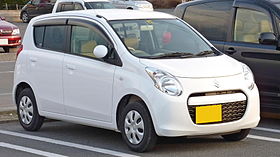 2010 Suzuki Alto | |
| Overview | |
| Model code | HA25 |
| Also called | Mazda Carol |
| Production | 2009–2014 |
| Assembly | Japan:Kosai, Shizuoka |
| Body and chassis | |
| Body style | 5-doorhatchback |
| Layout | Front-engine, front-wheel-driveorfour-wheel-drive |
| Powertrain | |
| Engine | |
| Transmission | 5-speedmanual 4-speedautomatic CVT |
| Dimensions | |
| Wheelbase | 2,400 mm (94.5 in) |
| Length | 3,395 mm (133.7 in) |
| Width | 1,475 mm (58.1 in) |
| Height | 1,535 mm (60.4 in) |
The seventh-generation Alto was first shown at the2009 Tokyo Motor Showalongside its sister car, the Mazda Carol. It is available with a 660 cubic centimetres (40 cu in) engine, a 5-speed manual, a 4-speed automatic transmission or aCVT,inFWDor 4WD variants. Under the Japanese 10-15 test cycle, the front-wheel-drive with CVT achieves 24.5 km/litre fuel economy.[42]
In 2011, Suzuki launched the Alto Eco variant, that features theR06Aengine lifted from theSuzuki MR Wagonand an idling stop function. It is capable of reaching 30.2 km/L (85 mpg‑imp;71 mpg‑US) based on Japan's JC08 Mode test cycle (32 km/L under 10-15 test cycle). This is.2 km/L higher than theDaihatsu Mira e:S.[43]
In 2013, the Alto Eco was updated with the addition of Suzuki's ENE-CHARGE system, first applied on the fifth generation Wagon R. With this technology, fuel economy has now improved to33.0 km/Lbased on Japan's JC08 Mode test cycle.[44]
-
Suzuki Alto Van (HA25S)
-
Suzuki Alto Eco-L (HA35S)
-
Suzuki Alto Eco-L (HA35S)
-
Interior
International
[edit]| Maruti Suzuki A-Star | |
|---|---|
 2014 Suzuki Alto (GF) SZ (UK) | |
| Overview | |
| Also called | Suzuki Alto Suzuki Celerio Nissan Pixo |
| Production | 2008–2014 (India) 2009–2018 (China) |
| Assembly |
|
| Body and chassis | |
| Class | City car(A) |
| Body style | 5-doorhatchback |
| Layout | Front-engine, front-wheel-drive |
| Powertrain | |
| Engine | 998 ccK10BI3 |
| Transmission | 5-speedmanual 4-speedautomatic |
| Dimensions | |
| Wheelbase | 2,360 mm (92.9 in) |
| Length | 3,580 mm (140.9 in) |
| Width | 1,680 mm (66.1 in) |
| Height | 1,400 mm (55.1 in) |
| Chronology | |
| Predecessor | Maruti Alto(India) |
| Successor | Nissan Micra(for Nissan Pixo, Europe) Suzuki Celerio(Asia) |
The Suzuki Alto available in international market is known in India as the Maruti Suzuki A-Star (short for "Alto-Star" ), but is also known as theSuzuki Celerioin some other countries. It was launched in December 2008 by Suzuki's Indian subsidiaryMaruti Suzuki.
It is actually a different car from the Japanese market one although they share the same name. The car is manufactured exclusively inHaryana,India and is exported worldwide. It is available in some European markets with a somewhat different front end as the Nissan Pixo. The car was rolled out to the Indian customers in December 2008 and exports began in April 2009.
With a totally new body and engine, Maruti hopes to bring freshness to the Indian car market, of which it already holds a major share. The 998 cc (60.9 cu in)K10Binline-three engine was developed especially for the new car, and is also used for the Nissan Pixo. The A-Star has a fresh new dashboard, with an available unique protruding tachometer besides the usual meter cowl (only in the ZXi trim).
In February 2014, Maruti Suzuki unveiled an all-new Celerio, which replaces the A-Star andZen Estilo.[45][46]
The European market version of the Maruti Suzuki A-Star was unveiled at the2008 Paris Motor Show.It was developed to be a global car and will be made atMaruti Suzuki's plant inManesar,Haryana,India. It is stylistically based on the Suzuki A-Star Concept.[47]The Alto was conceived as a response to high petrol prices and global warming. It was released as an eco-friendly car priced from £6,795 OTR.[48]
-
2014 Suzuki Alto (GF) SZ (UK)
-
Suzuki Alto facelift (China)
-
Suzuki Alto facelift (China)
Nissan Pixo
[edit]The Nissan Pixo is the "sister car" to the Suzuki Alto. Mechanically, both cars are very similar; however, there are a few notable exterior differences, including the main grille and headlamps.[49]It was launched at the2008 Paris Motor Showand was available in Europe from 2009 to 2013.[50]Because it was developed and built cheaply in India, the Pixo was sold for just under £7,000.[51]In the summer of 2013, the Pixo was withdrawn from UK showrooms.
The Nissan Pixo was reviewed, and subsequently mocked, byTop Gearin series 17. The review became aTop Gear challengewhereJeremy ClarksonandRichard Hammondbought cars on the second hand market for the same price as a new Pixo. Clarkson bought a 2002 MercedesMercedes CL600for £6995, and Hammond bought a 1994BMW 850cifor £6,700.James Maydefended the Pixo, arguing that it was more modern, reliable and economical than the two luxury cars.[52]
-
Nissan Pixo (Europe)
-
Nissan Pixo (Europe)
Suzuki Alto 800
[edit]In 2012, India's Maruti introduced a low cost replacement for the original Maruti 800 called the Alto 800. This was also exported to many markets outside of Europe and sold as the Suzuki Alto 800, while some markets simultaneously offered the pricier A-Star as the Suzuki Alto.
Eighth generation (2014)
[edit]| Eighth generation | |
|---|---|
 Suzuki Alto L (HA36S) | |
| Overview | |
| Model code | HA36S/V |
| Also called | Mazda Carol |
| Production |
|
| Assembly |
|
| Body and chassis | |
| Body style | 5-doorhatchback |
| Layout | Front-engine, front-wheel-driveorfour-wheel-drive(Japan) |
| Platform | HEARTECTplatform |
| Related | Suzuki Lapin |
| Powertrain | |
| Engine | |
| Transmission |
|
| Dimensions | |
| Wheelbase | 2,460 mm (96.9 in) |
| Length | 3,395 mm (133.7 in) |
| Width | 1,475 mm (58.1 in) |
| Height |
|
| Curb weight |
|
The eighth-generation Alto was introduced in Japan in December 2014.[53][54]The new Alto was the first Suzuki's car designed on lightweightHEARTECTplatform. It is also the first Alto that usingtorsion beammodel rear suspension, replacing the old 3-link model (except for all-wheel-drive models). The new lightweight platform, lighter body, engine, seats and simpler rear suspension made the car 60 kg (132 lb) lighter than the outgoing model.[53][54]This car was also designed to have a very low fuel consumption, achieved using "Suzuki Green Technology" for the body and the engine, and resulted in the car having a claimed fuel consumption of 37 km/L (100 mpg‑imp;87 mpg‑US).[53]
The conventional models of the new Alto is available in five trim levels. The passenger variant are called "F", "L", "S" and "X", plus a commercial van variant called "VP". All powered with a naturally-aspiratedK06A658 cc (40.2 cu in)inline-three engine,from previous generation. This engine received major improvement in fuel efficiency by raising the compression ratio and adopting theexhaust gas recirculation(EGR) system (excludes "F" trim with manual transmission and "VP" van), while enhancing the low-to-mid speed driving performance by newly designing the intake and exhaust systems. The weight also reduced by adopting a cylinder head integrated with an exhaust manifold and simplifying the catalyzer case.[53]It is mated with either a 5-speed manual transmission ( "F" and "VP" ), a 5-speedautomated manual transmissioncalledAuto Gear Shift(AGS) by Suzuki ( "F" and "VP" ), or aCVT( "L", "S" and "X" ).[54][55]All transmissions are available with all wheel-drive option. TheK06Aengine with manual transmission for "F" and "VP" trims are rated at 49 PS (36 kW) and 58 N⋅m (43 lb⋅ft), while the rest of the range produces three horsepower and four Nm more because those engines are fitted withVVT.[54]
A sporty variant intended for daily use called "Turbo RS" was introduced in March 2015[56]which was followed by a more spartan performance-tuned "Works" variant which made a comeback in December after 15 years of absence.[57]The Works had been discontinued as the market had shifted away from performance cars to instead concerning itself with economy and the environment; Suzuki made mention of the high fuel economy even of the Works model.[57]These high performance models are powered with the turbocharged variant ofK06Aengine, producing 64 PS (47 kW) and 98 N⋅m (72 lb⋅ft) - ( "Works" has two Nm more than the Turbo RS).[56][58]It is paired with either a 5-speed manual (not available for "Turbo RS" ) or automated manual transmission with taller gear ratios than the less powerful "F" and VP "trims. The handling is also reworked with new wider high performance tires fromBridgestone,shock absorberfromKYB,ventilated front disc brakes,strut barto increase body's rigidity, rearstabilizer barfor front wheel-drive models (also available for "X" trim).[56][58]
For the interior, unlike the previous generation, adjustable front seats head rest and 50:50 foldable back seats (still with adjustable head rest, excluding "VP", "F" and "L" trims) are deleted. All natural aspirated engined models received two tone black and white colours. In 2018, the seat upholstery was replaced with dark blue colour for "L", "S" and "X" trims. "Turbo RS" and "Works" trims has black with red accents interior colour, leather wrapped steering wheel, paddle shift for AGS models and tachometer.[56][58]The "Works" trim added racing front seats fromRecaro,stainless steel pedals and turbo boost meter.[58]
In term of exterior, all naturally aspirated models are using halogen headlights as standard and 13 inches steel wheels with hubcaps (except "VP" ) and "X" with special two tone colours. The "Turbo RS" and "Works" received more sporty bumpers, side skirts, rear upper spoiler, fog lights, stickers, 15 inches aluminium wheels fromEnkei(also available for "X" trim), front brake calipers with red colour for "Works" andHIDheadlights.
The safety is also upgraded with additionalelectronic stability controlandcollision avoidance system.[53]The car achieved 4 of 5 stars in crash tests performed byJNCAP.[59]
To celebrate the 40-year anniversary of Alto, a special edition called "L Limited" was launched in June 2019.[60]The car is based on "L" trim with additional accessories and features from higher trims.
The "Turbo RS" trim was discontinued in December 2018, followed by "X" trim in October 2020, "VP" commercial van in August 2021 and finally replaced by ninth generation four months later.
-
Suzuki Alto Van VP (HA36V)
-
Suzuki Alto Van VP (HA36V)
-
Suzuki Alto X two tone (HA36S)
-
Suzuki Alto RS (HA36S)
-
Suzuki Alto RS (HA36S)
-
Interior (Alto X)
-
Interior (Alto Works)
Pakistan
[edit]The eighth-generation Alto was revealed for the Pakistani market on 12 April 2019 at thePakistan Auto Show(PAPS). The car is sold in three variants: "VX", "VXR" and "VXL". The "VX" being the base model with minimal equipment, no air conditioning and a 5-speed manual transmission; the "VXR" variant gaining twin airbags, power locks, power steering, etc.; while the premium "VXL" model is further equipped with air conditioning, ABS brakes, and an automated manual transmission "AGS".[61]
The local manufacturing of Alto has made Pakistan one of the few countries in the world that locally manufactureskei cars.Currently, Pakistan is the only country other than Japan to locally manufacture this generation of Suzuki Alto.Pak Suzuki Motors' second generation Alto looks cosmetically the same as the Japanese-made one and is powered by the same engine.[62]It is rated at 39.5 PS (29 kW) and 56 N⋅m (41 lb⋅ft), lower than Japanese model because the lower compression ratio (10 vs 11.5), lack of VVT and several other differences.
Ninth generation (2021)
[edit]| Ninth generation | |
|---|---|
 2021 Alto Hybrid X (HA97S) | |
| Overview | |
| Model code | HA37/HA97 |
| Also called | Mazda Carol |
| Production | 2021–present |
| Assembly | Japan:Kosai, Shizuoka |
| Designer | Alessandro Di Gregorio and Ayano Oshita |
| Body and chassis | |
| Body style | 5-doorhatchback |
| Layout | Front-engine, front-wheel-driveorfour-wheel-drive |
| Platform | HEARTECTplatform |
| Related | Suzuki Wagon R Smile |
| Powertrain | |
| Engine | 657 ccR06DI3(MHEV) 658 ccR06AI3 |
| Electric motor | WA04CDC synchronous |
| Transmission | CVT |
| Hybrid drivetrain | Mild hybridwithIntegrated Starter Generator (ISG) |
| Battery | 3AhLithium Ion |
| Dimensions | |
| Wheelbase | 2,460 mm (96.9 in) |
| Length | 3,395 mm (133.7 in) |
| Width | 1,475 mm (58.1 in) |
| Height | 1,525 mm (60.0 in) |
| Curb weight | 680–760 kg (1,499–1,676 lb) |
The ninth-generation Alto was introduced in Japan in December 2021.[63]It is continued to be built on lightweightHEARTECTplatformand powered with the sameR06Aengine for the conventional models. Additionally, the car received newR06Dengine with mild hybrid system that was also seen inSuzuki Wagon R Smile.CVTis the only transmission that available in this generation and became the first Alto without manual transmission option.[63]TheAuto Gear Shift (AGS)automated manual transmissionis also abolished.
The exterior styling is penned by Alessandro Di Gregorio, designer of Suzuki European Design Center in Italy:[64][65]aesthetically the whole body presents softer, friendlier and less angular lines while still recalling the design of the previous generation. The windscreen is more vertical to make the passenger compartment more spacious and the total height is increased.
Four trim levels are available, "A" and "L" for conventional model and "S" and "X" for hybrid model.[63]
-
Rear view
-
Interior
References
[edit]- ^Quattroruote: Tutte le Auto del Mondo 1994(in Italian). Milano: Editoriale Domus S.p.A. 1994. p. 554.
- ^"European car sales data: Suzuki Alto".Left Lane. 31 January 2014.Retrieved18 August2016.
- ^"Four Million Production of Kosai ALTO".Global Suzuki. 7 August 2001.Retrieved17 July2013.
- ^abWebster, Mark (2002),Assembly: New Zealand Car Production 1921-98,Birkenhead, Auckland, New Zealand: Reed, p. 152,ISBN0-7900-0846-7
- ^ab"Suzuki to double auto production in Pakistan".Nihon Keizai Shimbun.Tokyo: 10. 20 November 1984.
- ^abcde"Suzuki Hatch".Unique Cars and Parts.Retrieved26 January2014.
- ^abcYamaguchi, Jack K. (1980), Lösch, Annamaria (ed.), "Consummation of the Turbulent Decade",World Cars 1980,Pelham, New York: L'Editrice dell'Automobile LEA/Herald Books:66–67,ISBN0-910714-12-6
- ^Ogawara, Kazuyo, ed. (16 June 2015),Chu khan nhật bổn の danh xa[Famous Japanese Cars Weekly], vol. 73, Tokyo: K.K. DeAgostini Japan, p. 3
- ^abcdBoyce, David, ed. (1981),What car is that?: in Australia & New Zealand,Adelaide, Australia: Rigby, p. 166,ISBN0727014803
- ^"GM ties with two Japanese car makers".Nihon Keizai Shimbun.Tokyo: 1. 18 August 1981.
- ^Hattori, Yoshi (June 1984). "Japan: Minica magic".Wheels.Sydney, Australia: Murray Publishers: 19.
Monthly sales in February were 5500 for the Fronte and 14000 for the Alto
- ^Car Graphic: Car Archives Vol. 11, '80s Japanese Cars(in Japanese), Tokyo: Nigensha, 2007, p. 261,ISBN978-4-544-91018-6
- ^Nakamura, Takahito; Piazzi, Filippo (July–September 1984). Marin, Gianni (ed.). "Suzuki: Come ti scodello la" Panda 4x4 ""[Suzuki: Dishing it out to the Panda 4x4].Auto in Fuoristrada(in Italian).3(7). Milan: Rusconi Editore: 55.
- ^Tự động xa ガイドブック[Japanese Motor Vehicles Guide Book 1984~'85] (in Japanese), vol. 31, Japan:Japan Automobile Manufacturers Association,20 October 1984, p. 224, 0053-840031-3400
- ^Tự động xa ガイドブック[Japanese Motor Vehicles Guide Book 1985~'86] (in Japanese), vol. 32, Japan:Japan Automobile Manufacturers Association,30 October 1985, p. 236, 0053-850032-3400
- ^New Alto(brochure) (in Japanese), Hamamatsu, Japan: Suzuki Motor Company, July 1986, pp. 10, 16, (61.7)99999-30101-102
- ^Quattroruote: Tutte le Auto del Mondo 1992.Milano: Editoriale Domus S.p.A. 1992. pp.974–976.
- ^Bhargava, R. C.; Seetha (2010).The Maruti Story.Noida, India: Collins Business. pp.116–117.ISBN9788172237806.
- ^"Mehran".Archived fromthe originalon 28 September 2015.Retrieved28 September2015.
- ^abLưu văn tuấn (Liu Wenjun) (24 August 2009).Áo thác: Trung quốc vi xa truyện kỳ[Alto: Chinese microcar legend].auto163.com(in Chinese). NetEase. Archived fromthe originalon 2 September 2009.
- ^Vương mãnh (Wang Meng) (21 November 2016).Nhĩ tái bất lão ngã tựu phong liễu khán khí xa giới đích bất lão nam thần[You're not old - crazy about old dream cars] (in Chinese). autohome.com.cn. Archived fromthe originalon 29 July 2017.
- ^"Zotye to Challenge Tata Nano with a $2,765 Alto".ChinaAutoWeb.com.
- ^"Jiangnan Alto, China's Cheapest Car from Zotye, Beats Tata Nano".ChinaAutoWeb.com.Retrieved13 January2010.
- ^"SUZUKI ALTO HUSTLE LE".carfromjapan.com.
- ^ab"Alto".U's Station on the Net - Short Catalog by Model.Suzuki Motor Corporation. Archived fromthe originalon 13 July 2010.
- ^Stark, Harry A.; Bush, James W., eds. (1990).Ward's Automotive Yearbook 1990.Vol. 52. Detroit, MI: Ward's Communications, Inc. p. 284.ISBN0910589010.
{{cite book}}:CS1 maint: ignored ISBN errors (link) - ^Anderson, Donn, ed. (April 1993). "Buzzy Bee!".New Zealand Car.7(6). Auckland, New Zealand: Accent Publishing Cnr: 40.ISSN0113-0196.
- ^"Goo-net Catalog: Suzuki Alto 1991 niên 9 nguyệt".Goo-net.Archived fromthe originalon 13 July 2010.
- ^abBuzzy Bee!,p. 42
- ^abcd"スズキアルトワークスR(H6 niên thức V-CM22V) chủ yếu chư nguyên"[1994 Suzuki Alto Works R (V-CM22V) specifications].わくわくわーく(in Japanese). Archived fromthe originalon 20 January 2018.
- ^abcスズキ・アルト[Suzuki Alto],カタログアーカイブシリーズ [Catalog Archives Series](in Japanese), no. 94, Tokyo, Japan: Grafis Mook, p. 69, March 2014,ISBN978-4-86493-138-0
- ^Alto L'Èpo(brochure, inSuzuki Alto Catalog Archive,p. 80) (in Japanese), Hamamatsu, Japan: Suzuki Motor Co., May 1996, pp.2–3, (96.5)99999-20106-100
- ^abAlto(brochure, inSuzuki Alto Catalog Archive,pp. 88-89) (in Japanese), Hamamatsu, Japan: Suzuki Motor Co., April 1997, pp.10–11, (97.4)99999-20100-240
- ^Phó のアルトワークスRのスペックです.[The specifications of my Alto Works R].Satoru's Home Page(in Japanese).
- ^"Suzuki Alto C pictures 1999".English.auto.vl.ru. Archived fromthe originalon 4 December 2010.Retrieved4 April2011.
- ^"Suzuki Works pictures 1998".English.auto.vl.ru. Archived fromthe originalon 3 December 2010.Retrieved4 April2011.
- ^"Suzuki Alto C2 pictures 2001".English.auto.vl.ru. Archived fromthe originalon 25 November 2010.Retrieved4 April2011.
- ^"Alto HA23S HA23V".U's Station on the Net - Short Catalog by Model.Suzuki Motor Corporation. Archived fromthe originalon 14 July 2010.
- ^"Pak Suzuki's Milestone".Pak Suzuki. Archived fromthe originalon 1 May 2017.
- ^abClopatofsky, José (11 August 1999)."Sorprendente el nuevo Chevrolet todo lo Alto"[Surprising new Chevrolet: all about the Alto].El Tiempo(in Spanish). Bogotá, Colombia. Archived fromthe originalon 1 July 2018.
- ^Fourie, Louis (2016).On a Global Mission: The Automobiles of General Motors International.Vol. 3 (1st ed.). Friesen Press. p. 1146.ISBN9781460296905.
- ^Tan, Paul (17 December 2009)."JDM Mazda Carol based on Suzuki Alto".Paul Tan.org.
- ^"Emission Test Cycles: Japanese JC08 Cycle".dieselnet.com.Retrieved9 September2021.
- ^"スズキ, “アルト エコ” を nhất bộ cải lương し, đê nhiên phí 33.0km/L ( 2WD xa ) を đạt thành "[Detail improvements to Suzuki's "Alto Eco" helps it achieve a fuel consumption of 33.0 km/L (2WD)] (in Japanese). Autoc one. 20 February 2013. Archived fromthe originalon 23 March 2014.
- ^Chauhan, Chanchal Pal (7 February 2014)."Auto Expo 2014: Maruti Celerio hatchback launched at a starting price of Rs 3.90 lakh".The Economic Times.Archived fromthe originalon 16 February 2014.Retrieved16 February2014.
- ^Mohan, Anand (14 February 2014)."Maruti Celerio: Competition Check".The Economic Times.Retrieved16 February2014.
- ^Tan, Paul."New Suzuki Alto images released, details to come".Paultan.org.Retrieved17 September2011.
- ^"Suzuki Alto - The Newest Eco Friendly Car".Motoring-blog.com. 21 August 2008. Archived fromthe originalon 31 March 2009.Retrieved17 September2011.
- ^"New Nissan Pixo Car Review".Parkers.Retrieved17 September2011.
- ^"Nissan at the 2008 Paris International Motor Show".Nissan. 12 September 2008. Archived fromthe originalon 23 September 2012.
- ^"New Nissan Pixo Car Review - Facts & Figures".Parkers.Retrieved17 September2011.
- ^"Top Gear: Series 17, Episode 3 – TopGearbox".31 July 2011.
- ^abcde"Suzuki launches the all-new Alto minicar in Japan"(Press release). Global Suzuki. 22 December 2014.Retrieved23 December2014.
- ^abcd"スズキ, khinh tự động xa tân hình “アルト” を phát mại "(Press release) (in Japanese). Suzuki Japan. 22 December 2014.
- ^K, Nithyanandh (13 December 2014)."Official images of 2015 Suzuki Alto kei car released – Japan".IndianAutosBlog.Retrieved23 December2014.
- ^abcd"スズキ, khinh thừa dụng xa tân hình “アルト ターボRS” を phát mại ".Suzuki Japan(Press release) (in Japanese). 11 March 2015.
- ^ab"15 niên ぶり phục hoạt phát mại スズキ “アルトワークス” "[Suzuki Alto Works relaunches after 15 years].Shizuoka Shimbun(in Japanese). 25 December 2015. Archived fromthe originalon 25 December 2015.
- ^abcd"スズキ, khinh thừa dụng xa tân hình “アルト ワークス” を phát mại ".Suzuki Japan(Press release) (in Japanese). 24 December 2015.
- ^"Suzuki Alto / Mazda Carol".Nasva.
- ^"スズキ, khinh thừa dụng xa “アルト” に “40 chu niên ký niệm đặc biệt sĩ dạng xa Lリミテッド” を thiết định して phát mại "(Press release) (in Japanese). Suzuki Japan. 13 June 2019.
- ^"Suzuki Alto 2020 Overview, Specs & Features".PakWheels.com.Archived fromthe originalon 30 December 2020.
- ^"Pakistan's first 660cc 'Alto' all set to disrupt local automobile market".Profit.Pakistan Today. 15 June 2019. Archived fromthe originalon 18 June 2019.
- ^abc"スズキ, khinh thừa dụng xa tân hình “アルト” を phát mại ".Suzuki Japan(Press release) (in Japanese). 10 December 2021.
- ^Colombo, Emanuele (7 December 2023)."Suzuki Alto Hybrid: video prova della kei car per neopatentati"(in Italian).
- ^"Japan Platform for Patent Information".17 March 2022.
External links
[edit]- Official website(in Japanese)



